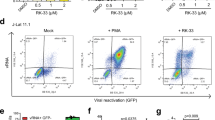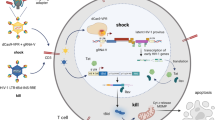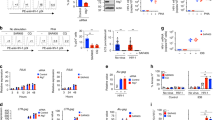Abstract
At present, treatment of HIV infection uses small inhibitory molecules that target HIV protease; however, the emergence of resistant HIV strains is increasingly problematic. To circumvent this, we report here a new 'Trojan horse' strategy to kill HIV-infected cells by exploiting HIV protease. We engineered a transducing, modified, apoptosis-promoting caspase-3 protein, TAT–Casp3, that substitutes HIV proteolytic cleavage sites for endogenous ones and efficiently transduces about 100% of cells, but remains inactive in uninfected cells. In HIV-infected cells, TAT–Casp3 becomes processed into an active form by HIV protease, resulting in apoptosis of the infected cell. This strategy could also be applied to other pathogens encoding specific proteases, such as hepatitis C virus, cytomegalovirus and malaria.
This is a preview of subscription content, access via your institution
Access options
Subscribe to this journal
Receive 12 print issues and online access
$209.00 per year
only $17.42 per issue
Buy this article
- Purchase on Springer Link
- Instant access to full article PDF
Prices may be subject to local taxes which are calculated during checkout





Similar content being viewed by others
References
Lillehoj, E.P. et al. Purification and structural characterization of the putative gag-pol protease of human immunodeficiency virus. J. Virol. 62, 3053–3058 (1988).
Kohl, N.E. et al. Active human immunodeficiency virus protease is required for viral infectivity. Proc. Natl. Acad. Sci. USA 85, 4686–4690 (1988).
Göttlinger, H.G., Sodroski, J.G. & Haseltine, W.A. Role of capsid precursor processing and myristoylation in morphogenesis and infectivity of human immunodeficiency virus type 1. Proc. Natl. Acad. Sci. USA 86, 5781– 5785 (1989).
Kaplan, A.H. et al. Selection of multiple human immunodeficiency virus type 1 variants that encode viral proteases with decreased sensitivity to an inhibitor of the viral protease. Proc. Natl. Acad. Sci. USA 91 , 5597–5601 (1994).
Gatlin, J., Arrigo, S.J. & Schmidt, MG. Regulation of intracellular human immunodeficiency virus type-1 protease activity. Virology 244, 87–96 (1998).
Coffin, J.M., Hughes, S.H. & Varmus, H.E. Retroviruses (Cold Spring Harbor Press, Cold Spring Harbor, New York, 1997).
Condra, J.H. et al. In vivo emergence of HIV-1 variants resistant to multiple protease inhibitors. Nature 374, 569– 571 (1995).
Gulnik, S.V. et al. Kinetic characterization and cross-resistance patterns of HIV-1 protease mutants selected under drug pressure. Biochemistry 34, 9282–9287 ( 1995).
Tisdale, M. et al. Cross-resistance analysis of human immunodeficiency virus type 1 variants individually selected for resistance to five different protease inhibitors. Antimicrob. Agents Chemother. 39, 1704–1710 (1995).
Salvesen, G.S. & Dixit, V.M. caspases: intracellular signaling by proteolysis. Cell 91, 443– 446 (1997).
Henkart, P.A. ICE family proteases: mediators of all apoptotic cell death? Immunity 4, 195–201 ( 1996).
Cohen, G.M. caspases: the executioners of apoptosis. J. Biochem. 326, 1–16 (1997).
Woo, M. et al. Essential contribution of caspase 3/Casp3 to apoptosis and its associated nuclear changes. Genes Dev. 12, 806–819 (1998).
Enari, M. et al. A caspase-activated DNase that degrades DNA during apoptosis, and its inhibitor ICAD. Nature 391, 43– 50 (1998).
Liu, X. et al. DFF40 induces DNA fragmentation and chromatin condensation during apoptosis. Proc. Natl. Acad. Sci. USA 15, 8461–8466 (1998).
Ratner, L. et al. Complete nucleotide sequence of the AIDS virus, HTLV-III. Nature 313, 277–284 (1985).
Rice, C.M. in Fields Virology (eds. Fields, B.N., Knipe, D.M. & Howley, P.M.) 931–960 (Lippincott-Raven, Philadelphia, 1996).
Welch, A.R., Woods, A.S., McNally, L.M., Cotter, R.J. & Gibson, W. A. Herpesvirus maturational protease, assemblin: identification of its gene, putative active site domain, and cleavage site. Proc. Natl. Acad. Sci. USA 88, 10792 –10796 (1991).
Francis, S.E., Sullivan, D.J. Jr. & Goldberg, D.E. Hemoglobin metabolism in the malaria parasite Plasmodium falciparum. Annu. Rev. Microbiol. 51, 97–123 (1997).
Barrie, K.A. et al. Natural variation in HIV-1 protease, gag p7 and p6, and protease cleavage sites within gag/pol polyproteins: amino acid substitutions in the absence of protease inhibitors in mothers and children infected by human immunodeficiency virus type 1. Virology 219, 407– 416 (1996).
Ezhevsky, S.A. et al. Hypo-phosphorylation of the retinoblastoma protein by cyclin D:Cdk4/6 complexes results in active pRb. Proc. Natl. Acad. Sci. USA 94, 10699–10704 ( 1997).
Lissy, N.A. et al. TCR-antigen induced cell death (AID) occurs from a late G 1 phase cell cycle check point. Immunity 8, 57–65 (1998).
Nagahara, H. et al. Highly efficient transduction of full length TAT fusion proteins directly into mammalian cells: p27Kip1 mediates cell migration. Nature Med. 4, 1449–1452 (1998).
Vocero-Akbani, A. et al. Transduction of full length TAT fusion proteins directly into mammalian cells:analysis of TCR-activation induced cell death (AID) in Methods in Enzymology (ed. Reed, J.C.) (Academic, San Diego, in the press).
Coates, P.J. Molecular methods for the identification of apoptosis in tissues. J. Histotechnol. 17, 261–267 (1994).
Xiang, J., Chao, D.T. & Korsmeyer, S.J. Bax-induced cell death may not require interleukin 1B-converting enzyme-like proteases. Proc. Natl. Acad. Sci. USA 93, 14559–14563 ( 1996).
Westervelt, P., Genedelman, H.E. & Ratner, L. Identification of a determinant within the HIV-1 surface envelope glycoprotein critical for productive infection of cultured primary monocytes. Proc. Natl. Acad. Sci USA 88, 3097–3101 (1991).
Lou, X., Budihardjo, I., Zou, H., Slaughter, C. & Wang, X. Bid, a Bcl2 interacting protein, mediates cytochrome c release from mitochondria in response to activation of cell surface death receptors. Cell 94, 481– 490 (1998).
Li, H., Zhu, C.-j. & Yuan, J. Cleavage of BID by caspase 8 mediates the mitochonrial damage in Fas pathway of apoptosis. Cell 95, 491–501 (1998).
Wong, J.K. et al. Recovery of replication-competent HIV despite prolonged suppression of plasma viremia. Science 278, 1291– 1295 (1997).
Finzi, D. et al. Identification of a reservior for HIV-1 patients on highly active antiretroviral therapy. Science 278, 1295 –1300 (1997).
Wu, X. et al. Functional RT and IN incorporated into HIV-1 particles independently of the Gag/Pol precursor protein. EMBO J. 16, 5113–5122 (1997).
Acknowledgements
We thank E.S. Alnemri for the human Casp3 cDNA; K. Wang for help with DEVD-AFC reactions; Abbott Labs for Ritonavir; S. Horning for doing the TUNEL assays; and D. Goldberg, C. Rice, S. Virgin and all the members of the Dowdy and Ratner labs for critical input. This work was supported by the N.I.H. (L.R.) and the Howard Hughes Medical Institute (S.F.D.). S.F.D. is an Assistant Investigator of the Howard Hughes Medical Institute.
Author information
Authors and Affiliations
Corresponding author
Rights and permissions
About this article
Cite this article
Vocero-Akbani, A., Heyden, N., Lissy, N. et al. Killing HIV-infected cells by transduction with an HIV protease-activated caspase-3 protein. Nat Med 5, 29–33 (1999). https://doi.org/10.1038/4710
Received:
Accepted:
Issue Date:
DOI: https://doi.org/10.1038/4710
This article is cited by
-
Application of Cell Penetrating Peptides as a Promising Drug Carrier to Combat Viral Infections
Molecular Biotechnology (2023)
-
Disruption of blood–brain barrier: effects of HIV Tat on brain microvascular endothelial cells and tight junction proteins
Journal of NeuroVirology (2023)
-
Cancer targeting peptides
Cellular and Molecular Life Sciences (2019)
-
Progress in Research and Application of HIV-1 TAT-Derived Cell-Penetrating Peptide
The Journal of Membrane Biology (2017)
-
Therapeutic evaluation of HIV transduction basic domain-conjugated superoxide dismutase solution on suppressive effects of the formation of peroxynitrite and expression of COX-2 in murine skin
Journal of Biomedical Science (2016)



